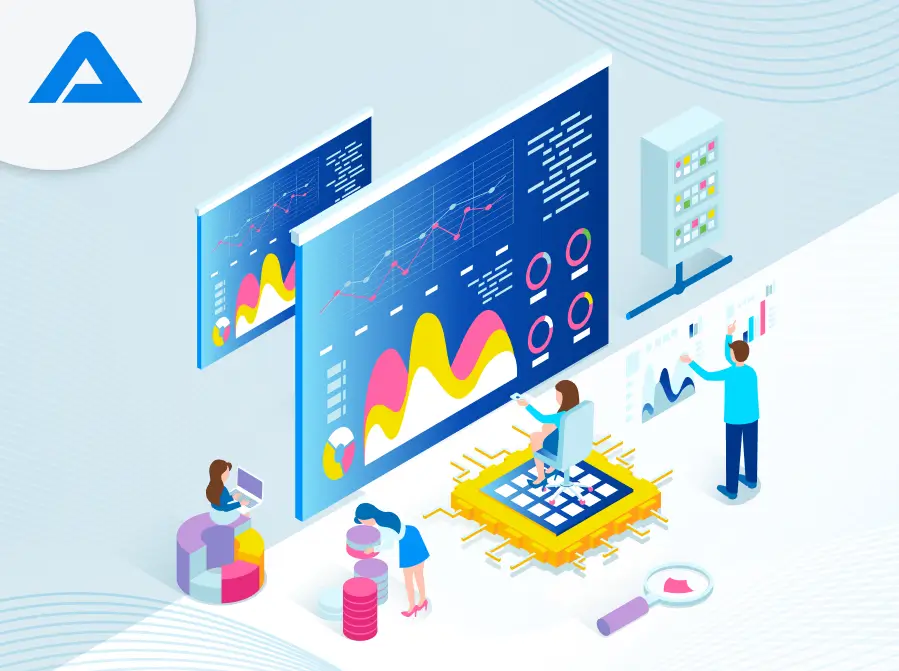Real-time big data analytics combine cutting-edge techniques and methodologies that harness the continual data stream. This essential tool can enhance efficiency, savings, and customer relationships.
Each day, individuals create a wealth of information. It is recorded every time somebody opens their mailbox or uses their mobile application, enters a store, buys something on the internet, or talks to an agent for customer service. Furthermore, Finance teams, employees, marketing plans, supply chains, and other aspects of the business produce a wealth of data.
Big data is the term used to describe vast amounts of information derived from various sources and presented in multiple types. Many companies have realized the value of not just collecting the information but also studying the data to make business-related choices using Machine learning or AI. This is where big analytics of data comes in.
What is Real-Time Big Data Analytics?
Real-time big data analytics refers to analyzing large amounts of data in real-time to discover patterns, trends, and other insights that could be applied to better decision-making—the type of analytics utilized in many sectors, such as retail, finance, healthcare, and transportation.
Big data analytics use vast amounts of data, which can be stored in platforms for big data, such as Databricks and Google Big Query. You’ll sometimes see Apache Hadoop or Spark used in conjunction with a large data stack.
In big data analytics, there are many ways they may be utilized. They are generally divided into two types: continuous analytics and on-demand analytics. Ongoing analytics refers to real-time analytics in which the data is examined when generated. The method involves the application of technologies for streaming analytics, which allow companies to analyze and process data as it enters their systems.
However, On-demand analytics is the process of querying data as needed, typically for specific requirements or questions from the business. Before that, on-demand analytics were most commonly used as they require the capability to stream data continuously.
Data streaming has been made possible on a large scale in the past few years, even at large amounts of data. On-demand analytics are supported by numerous analytics systems that have been used for decades.
In addition to distinguishing between on-demand and continuous analytics, there are four kinds of analytics. The four types of analytics are descriptive, diagnostic, predictive, and prescriptive. The kind of analytics you require depends on the challenge you want to resolve or the objectives you want to accomplish.
Types of Real-Time Big Data Analytics
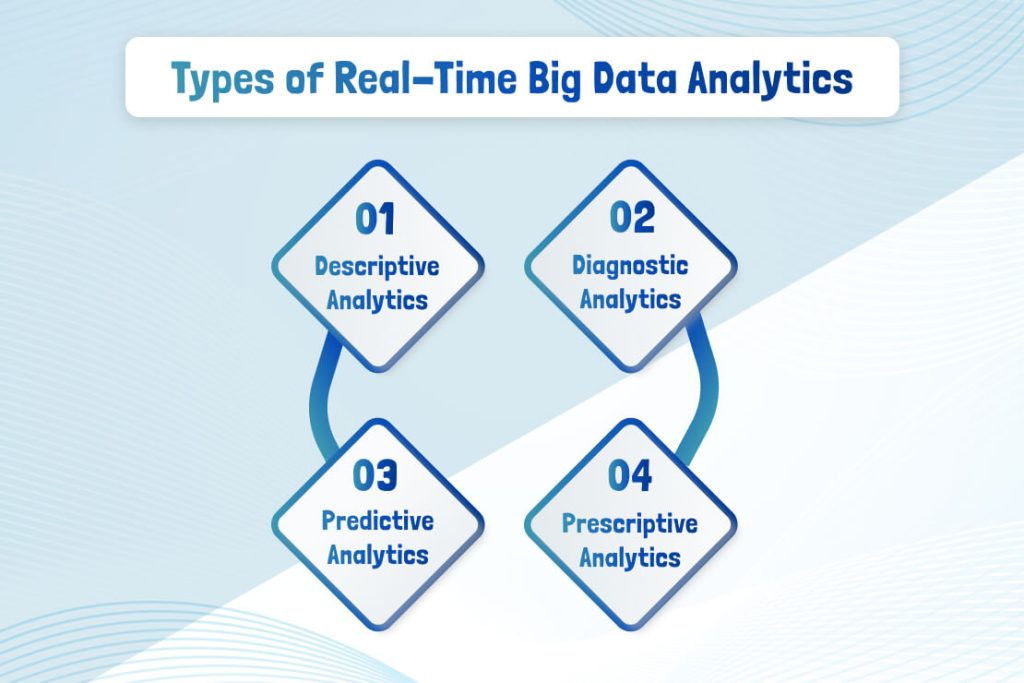
Let’s take a look at each of them in more depth:
Descriptive Analytics
This kind of analysis involves analyzing data from the past to get insight into the events that occurred and what caused it. Descriptive analytics are utilized to discover patterns, trends, and patterns in data from the past. The types of analytical descriptive comprise the sales report, customer behavior analysis, and monitoring social media regularly.
Diagnostic Analytics
Analytical analysis is the procedure of looking over data to discover the root cause that led to the incident. Analytical diagnostics can be utilized to identify the root of an issue or pinpoint those responsible for an outcome. Examples of diagnostic analytics include examination of the causes of customer churn analyses and A/B testing.
Predictive Analytics
The type of analytics described above is based on historical data to predict new events or developments. Predictive analytics can anticipate future demands, spot risk areas, and enhance operations. Predictive analytics examples comprise forecasting demand, analysis of risk, and prediction of customer lifetime value.
Prescriptive Analytics
This kind of analysis uses data to decide the best path to follow in a given circumstance. Prescriptive analytics can improve operations, boost decisions, and decrease expenses. Examples of prescriptive analytics are optimizing the use of resources, dynamic pricing, and optimizing supply chains.

How Do Real-Time Big Data Analytics Work?
The real-time way that big data analytics operates is an essential aspect of learning how to utilize the advantages associated with their benefits. Real-time data analysis works by processing and ingesting vast data with specialized software tools and technology.
In addition to creating actions or insights, the type of analytics involves multiple layers of processes to accomplish. It usually consists of the ingestion of data as well as processing, analysis, and then visualization. However, specific scenarios may not include specific steps, but this will represent the standard pattern. Let’s examine each part further.
Data Ingestion
Real-time information is obtained from sensors, IoT equipment, media sources, and transactions. It can be integrated with native software or using an external instrument. This is the stage at which data is transferred into the system, where analysis is performed.
Data Processing
The ingested data gets processed using streaming analytics tools that use real-time analytics algorithms to collect insight and spot patterns as the data moves. The process may involve modifications and processes to convert the data to the proper form. In the case of a particular use, some valuable insights could be discovered at this point.
Data Analysis
The data processed is then analyzed with machine-learning models and techniques for identifying patterns, trends, and anomalies. Patterns that are used to make informed decisions. This is the process that the most profound insight is typically derived.
Data Visualization
It might be beneficial to present the data in a visual format for specific scenarios to make it easier for users to understand. The results of the analysis are shown on charts and graphs. These help business professionals understand the information and take action quickly. Though not mandatory for analysis, dashboards and other visualizations can make the information more accessible.
In order to implement real-time big data analytics, companies must establish a solid data structure that can manage large quantities of data and support real-time processing. The typical architecture includes distributed storage like Hadoop and cloud-based data warehouses. It also includes real-time data processing systems that include Apache Kafka, Spark, or Flink.
Most businesses require experienced data scientists and analysts who can develop and implement real-time analytics and analyze the data. There are platforms available that can allow real-time analytics on big data, making the support from a data science team less crucial to gain insights.
Top Benefits for Business of Data Analytics in Real-Time
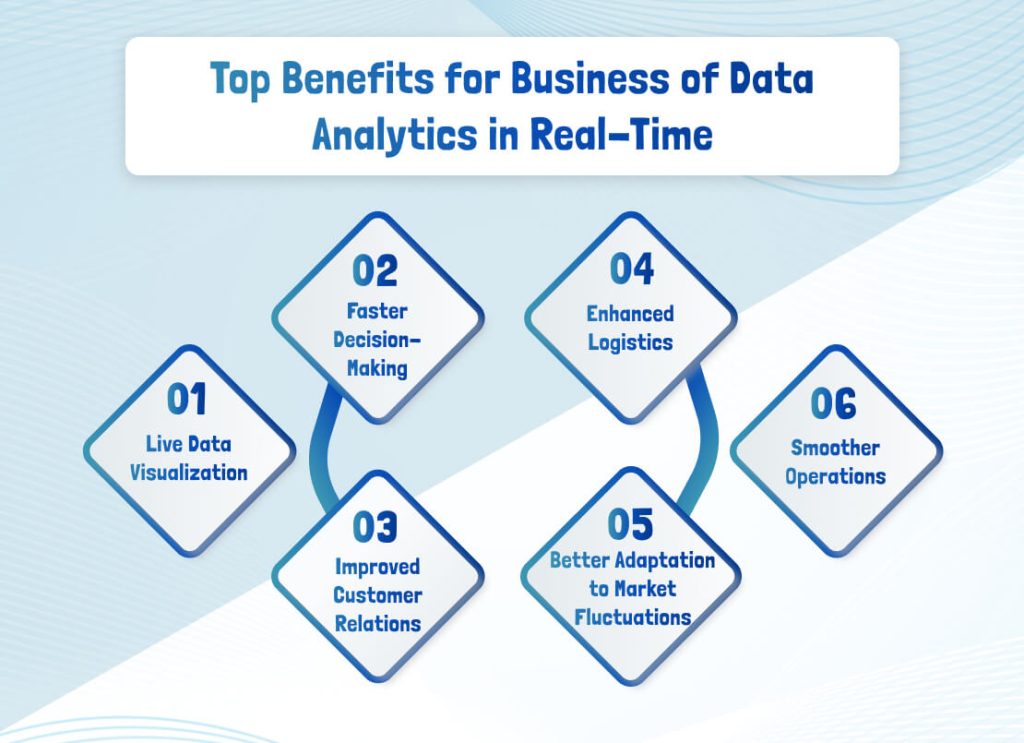
When you think about these questions, what are the potential business advantages of utilizing real-time information for analytical applications and other functions? These are the best ones.
Live Data Visualization
In the case of traditional data, people get a quick snapshot of data displayed on a graph. When using real-time data, the visualizations show any changes occurring in the company.
The dashboards must always be up to date. Users can modify their dashboards to communicate information quickly and efficiently to ensure that decisions are never delayed.
Faster Decision-Making
Each human being on Earth produces 1.7 million MB of information every second. With the abundance of data being generated from various sources, it’s challenging to organize and simplify crucial information without a quick decision-making method.
The advantages of processing data in real time allow you to make business choices swiftly and positively. Using accurate information that users have, they can eliminate or update information and introduce innovative business concepts and processes for the company with less risk.
Improved Customer Relations
Satisfaction of customers is the most crucial goal of every business. Through live reports, companies can examine customer needs in real-time, which allows for faster responses and higher levels of satisfaction with customers. Live analytics enable organizations to prioritize resources, necessary efforts, and promotions using data instead of thinking about it.
Enhanced Logistics
Make use of real-time analytics to comprehend the trends in shipping, reduce costs by removing routes that aren’t needed, update current inventory, and oversee warehousing processes.
In addition, the advantages of live data dramatically enhance supply chain logistics. Users will also gain better insights into the placement of product price strategies, managing operational risks, and improved labor efficiency and costs.
Logistics are discussed during development, allowing users to avoid possible flaws and help facilitate better and smoother operations.
Better Adaptation to Market Fluctuations
Specific industries are particularly vulnerable to sudden market changes, and commodities trading is one of them. The need for real-time data reports is vital for the survival of businesses in these circumstances.
Other industries, like hotel chains and airlines, regulate rates and availability following the current situation, which can alter quickly. The need for real-time information is essential in all these cases.
Since most modern business operations are online, companies and retailers must respond rapidly to changing demands, prices, and customer preferences.
By processing data in real time, users can detect these fluctuations, adjust to sudden market volatility, and reduce the possibility of losing money and declining customer satisfaction.
Smoother Operations
The productivity of employees can be increased efficiently by improving the operational process. Data analytics in real-time helps to discern current trends, how they’re implemented, and how improvements could be implemented.
For instance, facility managers can improve the allocation of space, develop preventative maintenance programs, and track organizational assets. Using real-time analytics, they can confirm that every component functions smoothly throughout the entire process.
Limitations in Real-Time Big Data Analytics
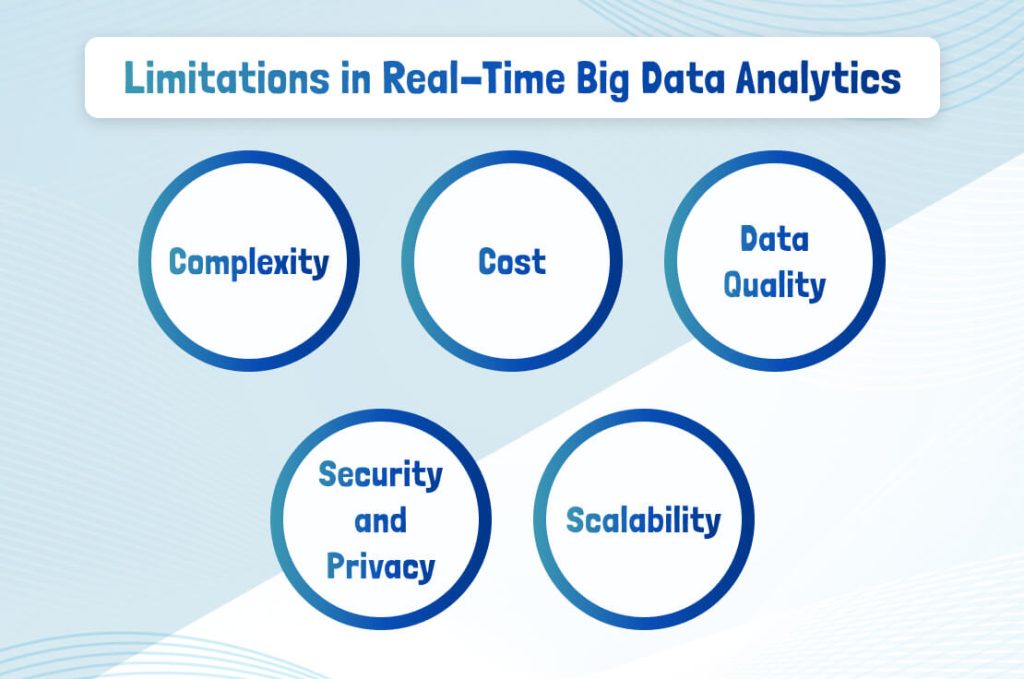
Like any other technology, there always will be some negatives or limitations to any given collection of technology. For real-time big data analytics, there are certain limitations Data warehousing consultant should be aware of. Some significant issues with real-time big data analytics are listed below.
Complexity
Big data analytics that is real-time requires the expertise of experts in a variety of areas, such as the field of data engineering, distributed systems, and machine learning. It is, therefore, difficult for companies to develop and sustain real-time analytics systems. In particular, a small-sized business might need more funds to employ engineers and data scientists to create and manage a real-time analytics platform. Technology and organizational challenges in implementing this analytics type could be pretty high.
Cost
In addition to the complexity of real-time, big data analytics may also be costly to set up and manage. It is especially so if businesses require specific hardware or software for its implementation. A financial institution might need to purchase top-of-the-line servers and storage equipment to process the massive amount of data produced through real-time analytics software. Some organizations may find the cost of this investment impossible to afford the necessary solution.
Data Quality
Real-time analytics based on big data need high-quality information that is precise, accurate, and up-to-date. The result could be better insights or decision-making if the data quality is good. This could result in revenue, customer, or user losses based on the specific use. A retailer, for instance, might use real-time analytics to modify pricing based on customers’ behavior; however, if the information needs to be more accurate or complete, this could lead to inaccurate pricing decisions.
Security and Privacy
The main requirement of many companies is handling sensitive data while keeping privacy and security at the forefront. In particular, at large scales, there is a challenge to managing large amounts of sensitive information in real-time, creating a risk to privacy and security. For example, a healthcare provider might use real-time analytics to monitor patient information. However, the data could be exposed to security breaches and threats if information isn’t adequately protected. If the environmental conditions are tightly monitored, the risk could result in reduced customer trust or legal troubles.
Scalability
When the analytics stack isn’t capable of scaling, it may lead to performance issues and delays. A social media site may employ real-time analytics to track the behavior of users; however, if the platform cannot be scaled enough to process the massive amount of data produced by millions of people, this can cause delays in taking in and analyzing the information. In the present, some of the information gleaned from analytics might be useful or relevant.
Ultimately, companies must be aware of the drawbacks to real-time big data analytics and compare them with the possible benefits before investing in a real-time analysis solution. By adjusting the tech stack utilized for the implementation of the solution and implementing it in a way that is customized, some or all the limitations could be overcome.
Challenges in Implementing Real-time Big Data Analytics
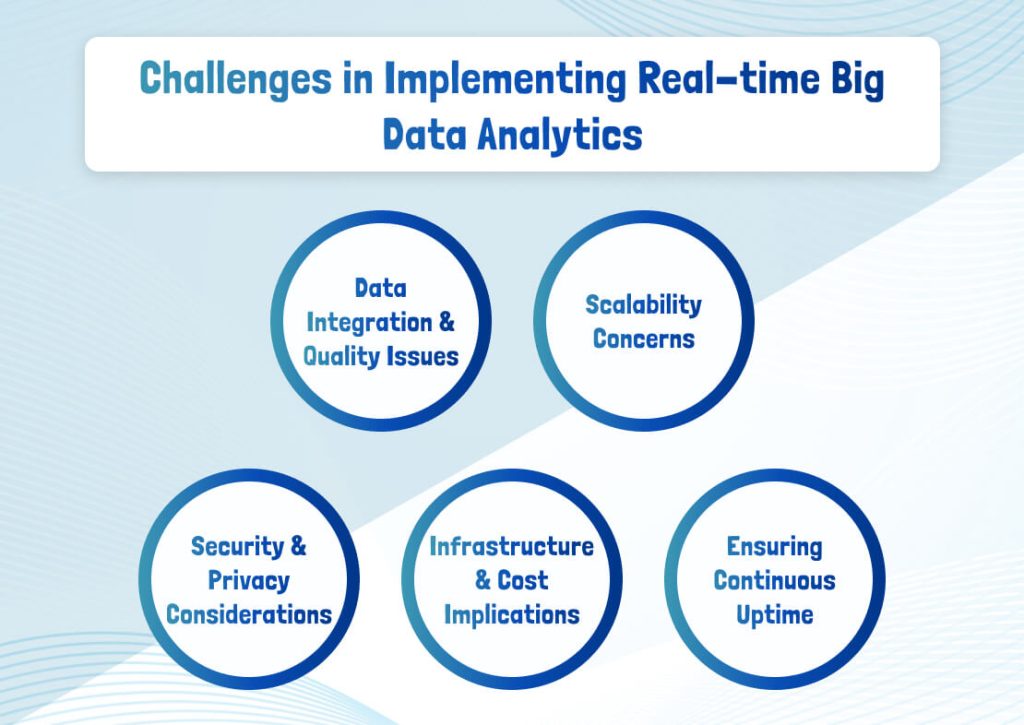
Each technological advance comes with a set of obstacles. Organizations should know these problems and devise strategies to get the best value from real-time analysis.
Data Integration & Quality Issues
Integrating various software and systems into an integrated analysis platform can be challenging. Businesses must guarantee data consistency, accuracy, timeliness, and precision across multiple sources. Additionally, the instantaneous nature of analytics requires that the data incorporated be top-quality. Poor quality data can lead to inaccurate information, which can harm decisions.
Scalability Concerns
Real-time processing often requires dealing with massive quantities, specifically in large companies. Analytics infrastructures must be flexible enough to manage these volumes of data efficiently. The traditional systems might need help and require investments in more modern technological advancements that are scalable. However, the transition could take a long time and cost firms.
Security & Privacy Considerations
In light of their continual data stream, real-time analytics systems could be at risk of cyberattacks. Additionally, regulations like GDPR and CCPA require stringent security measures for data privacy. The companies must find the right balance between rapid data mining and ensuring the security of the user is not compromised.
Infrastructure & Cost Implications
Real-time analytics systems are backed by investment in infrastructure and human resources. They incorporate fast processing equipment and storage and analytics tools that cost. The hiring or training of staff who are skilled in real-time analytics helps with the financial burden.
Ensuring Continuous Uptime
Since the analytics are real-time of analytics, any disruption could cause data loss or delay in the insights. In order to ensure that the system operates 24 hours a day requires careful planning and fail-safe solid systems.
Conclusion
The advent of AI development services in real-time analytics for big data can allow organizations to obtain actionable and thoughtful data in real-time, allowing them to take measures that can yield profitable business outcomes. This article has covered the fundamentals of real-time analytics for extensive data.
Data reigns supreme; big data isn’t any different. While it’s not easy to analyze big data, it has always assisted organizations in making more informed decisions, improving processes, and positioning them for the future. In addition to saving time and money and reducing risk, big data allows companies to create future-proof products to remain in front of competitors and drive innovation for more competitiveness.
Real-time data analytics help businesses convert massive data streams into effective strategies immediately. Companies can boost their efficiency and increase the value of the people they serve and the people they serve. If they do not use real-time analytics, this is akin to reacting rather than acting, resulting in being unprepared and losing relevance within the business.

Transform your business with real-time data magic—try it now!

Pooja Upadhyay
Director Of People Operations & Client Relations
